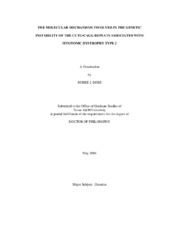| dc.description.abstract | Myotonic dystrophy type 2 (DM2) is caused by the extreme expansion (from <
30 repeats in normal individuals to ~ 11,000 for the full mutation in certain patients) of
the repeating tetranucleotide CCTG•CAGG sequence in the intron of the zinc finger
protein 9 (ZNF9) gene. The genetic instabilities of the CCTG•CAGG repeats were
investigated to evaluate the molecular mechanisms responsible for these massive
expansions. The effects of replication, recombination, repair and transcription on the
genetic instabilities have been investigated in COS-7 cells and E. coli model systems. A
replication assay was established in COS-7 cells wherein the CCTG•CAGG repeats
cloned proximal to the SV40 origin of replication resulted in expansions and deletions in
a length and orientation-specific manner, whereas the repeats cloned distal to the same
origin were comparatively stable. These results fit with our data obtained from
biochemical studies on synthetic oligonucleotides since these biochemical studies
revealed that the d(CAGG)26 oligomer had a marked propensity to adopt a hairpin
structure as opposed to its complementary d(CCTG)26 that lacked this capacity. Furthermore, a genetic assay in E. coli was used to monitor the intramolecular frequency
of recombination. This assay revealed that the tetranucleotide repeats were indeed hot
spots for recombination. Moreover, studies conducted in SOS-repair mutants showed
that recombination frequencies were much lower in a SOS¯ strain as compared to a SOS+
strain. However, experiments conducted to ascertain the level of induction of the SOS
response revealed that the SOS pathway was not stimulated in our studies. These results
revealed that although breaks may occur within the repeats, the damage is most likely
repaired without induction of the SOS response contrary to previous beliefs.
Thus, a complex interplay of replication, recombination, and repair is likely
responsible for the expansions observed in DM2. | en |


